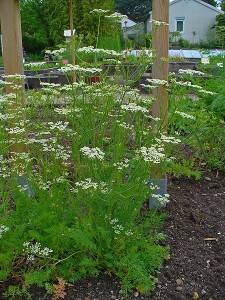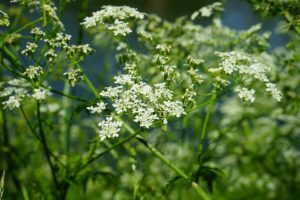
Caraway Plants
Caraway (Carum carvi) is a biennial that is usually grown for its fruit, often mistakenly referred to as “seed”, but the root and the foliage are also edible. The fruit, which has an anise flavor, is commonly dried and used whole in breads, desserts, and liquors. It is also used in sauerkraut, layered with the cabbage to reduce the odor of the cabbage as it cooks.
The fruit has long been used medicinally to alleviate indigestion, gas and cramps. The essential oil is used in mouthwash as a natural breath freshener, and in colognes.
Interestingly, caraway was used in love potions because it was believed that anything that contained caraway could not be stolen. It was also believed to prevent departures and used in pigeon feed to prevent them from straying.
The root of the caraway plant can be cooked and used like any other root vegetable such as carrots and parsnips. The leaves can be used fresh in salads or dried for use in the winter in soups.
Caraway is a member of the carrot family. It is native to Western Asia, Europe (except the Mediterranean region) and North Africa. It is most commonly grown now as a crop in Finland, which has long hours of sunlight in the summer, Netherlands, Central Europe, Canada and Egypt. Caraway is hardy in zones 3 through 9.

Caraway Flowers
The plants grow best in full sun, but will tolerate a little shade. They should be grown in rich, well drained soil. The plants themselves are only eight inches tall. The flower stems, which appear in the second year, can be 24 inches tall and tower over the plants. The flowers are white and in an umbel shape. They are irresistible to many beneficial insects, especially predatory insects. Bloom time is early summer.
Caraway is easy to grow from seed. The best way is to direct sow it, ¼ to ½ inch deep, in your garden in either the fall or early spring. Make sure that you plant it where you want it to grow. It has a long tap root and dislikes being transplanted. Germination should occur in 1 to 2 weeks. After germination, thin the seedlings to 8 inches apart. In northern climates (zones 3 – 6), caraway is often started indoors 4 to 6 weeks before the last frost and transplanted outdoors after the last frost. Start your seeds in peat pots or other biodegradable pots so that you can plant everything, pot and all, into your garden and not disturb the taproot.

Ripened Caraway Fruit
You may begin harvesting the leaves once the plants have reached 6 inches in height. The roots are harvested in the second year. This will kill the plant. The seeds, actually the fruit, are harvested in the fall when they have ripened and begun to dry on the plants. Harvest them carefully over a bag, basket or bowl and then winnow them using a screen to separate the seeds from the chaff. The seeds should be stored in a tightly sealed container away from sunlight, heat and humidity.

